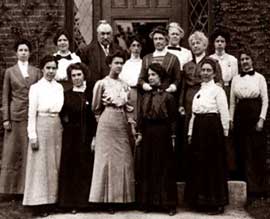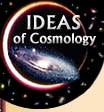
Pickering and his
"Harem," the stellar classification team at the Harvard
College Observatory.
(more info) |
Edward
Pickering,
the
newly appointed director of the Harvard College Observatory in 1881 and
an advocate of advanced study for women, grew so exasperated with his male
assistant's inefficiency that he declared that even his maid could do a
better job of copying and computing. So she did. And so did some twenty
more females at the Observatory over the next several decades. They were
recruited for their steadiness, adaptability, acuteness of vision, and willingness
to work for very low wages. The practice spread, due as much, perhaps, to
the rapid growth of new observatories as to the exemplary successes achieved
by early women workers. By 1920 well over a hundred women had worked at
various observatories in the United States. Women were not permitted to
observe, however, it being assumed that night-long vigils in a frigid dome
required a masculine physique. Nevertheless some, like Henrietta Leavitt,
made important discoveries. |


